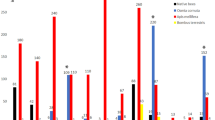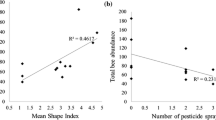Abstract
Enhancements of floral resources in surrounding landscape and in local crop fields are expected to mitigate adverse human impacts on pollinator diversity and pollination services. We evaluated whether intercropping with flowering basil (Ocimum basilicum) increases the local abundance and richness of bees and improves fruit and seed production of bell pepper (Capsicum annuum). Fields of bell pepper were divided into intercropping (basil mixed with pepper) and single-cropping plots (only pepper). We also grew bell peppers in protected greenhouse in the presence and absence of beehives. The richness and abundance of visiting bees to pepper flowers were greater in the intercropped plots than the single-cropping plots. The increase in the number of bees visiting the peppers was due to the stronger attraction of Paratrigona lineata, Apis mellifera and Tetragonisca angustula to basil in the intercropping plots. The pepper fruits produced in the intercropping were wider, longer, and heavier and developed more seeds than the fruits produced by single-cropping. The same differences were observed between the fruits grown in greenhouse with and without beehives of P. lineata. We demonstrate that agricultural systems designed to attract and retain pollinators are more productive than growing pure stands. Our results also highlight the role of provisioning floral resources to enhance bee conservation and management in anthropogenic ecosystems.


Similar content being viewed by others
References
Aizen MA, Garibaldi LA, Cunningham SA, Klein AM (2009) How much does agriculture depend on pollinators? Lessons from long-term trends in crop production. Ann Bot 103:1579–1588
Aleemullah M, Haigh MA, Holford P (2000) Anthesis, anther dehiscense, pistil receptivity and fruit development in the Longum group of Capsicum annuum. Aust J Exp Agric 40:755–762
Altieri MA, Nicholls CI (2004) Biodiversity and pest management in agroecosystems, 2nd edn. Food Products Press, New York
Andersson GKS, Rundlöf M, Smith HG (2012) Organic farming improves pollination success in strawberries. PLoS One 7(2):e31599. doi:10.1371/journal.pone.0031599
Balzan MV, Bocci G, Moonen AC (2014) Augmenting flower trait diversity in wildflower strips to optimize the conservation of arthropod functional groups for multiple agroecosystem services. J Insect Conserv 18:713–728
Benelli G, Benvenuti S, Desneux N, Canale A (2014) Cephalaria transsylvanica-based flower strips as potential food source for bees during dry periods in European Mediterranean basin countries. PLoS One 9:e93153. doi:10.1371/journal.pone.0093153
Benton TG, Vickery JA, Wilson JD (2003) Farmland biodiversity: is habitat heterogeneity the key? Trends Ecol Evol 18:182–1883
Blaauw BR, Isaacs R (2014) Flower plantings increase wild bee abundance and the pollination services provided to a pollination-dependent crop. J Appl Ecol 51:890–898
Calderone NW (2012) Insect pollinated crops, insect pollinators and US agriculture: trend analysis of aggregate data for the period 1992–2009. PLoS One 7(5):e37235. doi:10.1371/journal.pone.0037235
Carrié RJG, George DR, Wäckers FL (2012) Selection of floral resources to optimise conservation of agriculturally-functional insect groups. J Insect Conserv 16:635–640
Carvalheiro LG, Seymour CL, Nicolson SW, Veldtman R (2012) Creating patches of native flowers facilitates crop pollination in large agricultural fields: mango as a case study. J Appl Ecol 49:1373–1383
Chamberlain SA, Whitney KD, Rudgers JA (2013) Proximity to agriculture alters abundance and community composition of wild sunflower mutualists and antagonists. Ecosphere 4(8):96. doi:10.1890/ES13-00026.1
Constanza R et al (1997) The value of the world’s ecosystem services and natural capital. Nature 387:253–260
Cruz DO, Freitas BM, Silva LA, Silva EMS, Bonfim IGA (2005) Pollination efficiency of the stingless bee Melipona subnitida on greenhouse sweet pepper. Pesqui Agropecu Bras 40:1197–1201
Dag A, Kamer Y (2001) Comparison between the effectiveness of honeybee (Apis mellifera) and bumblebee (Bombus terrestris) as pollinators of greenhouse sweet pepper (Capsicum annuum). Am Bee J 141:447–448
Delaplane KS, Mayer DR, Mayer DF (2000) Crop pollination by bees. CABI, New York
Eardley C, Roth D, Clarke J, Buchmann S, Gemmill B (eds) (2006) Pollinators and pollination: a resource book for policy and practice. African Pollinator Initiative, Pretoria
Ercan N, Onus AN (2003) The effects of bumblebees (Bombus terrestris L.) on fruit quality and yield of pepper (Capsicum annuum L.) grown in an unheated greenhouse. Isr J Plant Sci 51:275–283
Freitas BM, Imperatriz-Fonseca VL, Medina LM, Kleinert AMP, Galetto L, Nates-Parra G, Quezada-Euán JJG (2009) Diversity, threats and conservation of native bees in the Neotropics. Apidologie 40:332–346
Gallai N, Salles JM, Settele J, Vaissière BE (2009) Economic valuation of the vulnerability of world agriculture confronted with pollinator decline. Ecol Econ 68:810–821
Garibaldi LA et al (2013) Wild pollinators enhance fruit set of crops regardless of honey bee abundance. Science 339:1608–1611
Garibaldi LA et al (2014) From research to action: enhancing crop yield through wild pollinators. Front Ecol Environ 12:439–447
Greco MK, Spooner-Hart RN, Beattie AGAC, Barchia I, Holford P (2011) Australian stingless bees improve greenhouse Capsicum production. J Apic Res 50:102–115
Gurr GM, Wratten SD, Luna JM (2003) Multi-function agricultural biodiversity: pest management and other benefits. Basic Appl Ecol 4:107–116
Gurr GM, Wratten SD, Altiere MA (eds) (2004) Ecological engineering for pest management: advances in habitat manipulation for arthropods. CSIRO, Collingwood
Gurr GM, Wratten SD, Snyder WE, Read DMY (eds) (2012) Biodiversity and insect pests: key issues for sustainable management. Wiley, Oxford
Kearns CA, Inouye DW, Waser NM (1998) Endangered mutualisms: the conservation of plant-pollinator interactions. Annu Rev Ecol Syst 29:83–112
Kennedy CM et al (2013) A global quantitative synthesis of local and landscape effects on wild bee pollinators in agroecosystems. Ecol Lett 16:584–599
Kevan PG, Phillips TP (2001) The economic impacts of pollinator declines: an approach to assessing the consequences. Conserv Ecol 5:10–20
Klein AM, Vaissière B, Cane JH, Steffan-Dewenter I, Cunningham SA, Kremen C, Tscharntke T (2007) Importance of crop pollinators in changing landscapes for world crops. Proc R Soc B: Biol Sci 274:303–313
Kovács-Hostyánszki A, Haenke S, Batáry P, Jauker B, Báldi A, Tscharntke T, Holzschuh A (2013) Contrasting effects of mass-flowering crops on bee pollination of hedge plants at different spatial and temporal scales. Ecol Appl 23:1938–1946
Landis DA, Wratten SD, Gurr GM (2000) Habitat management to conserve natural enemies of arthropods pests in agriculture. Annu Rev Entomol 45:175–201
Muniz JM, Pereira ALC, Valim JOS, Campos WG (2013) Patterns and mechanisms of temporal resource partitioning among bee species visiting basil (Ocimum basilicum) flowers. Arthropod-Plant Interact 7:491–502
Nicholls CI, Altieri MA (2013) Plant biodiversity enhances bees and other insect pollinators in agroecosystems. A review. Agron Sustain Dev 33:257–274
Peters VE, Carroll CR, Cooper RJ, Greenberg R, Solis M (2013) The contribution of plant species with a steady-state flowering phenology to native bee conservation and bee pollination services. Insect Conserv Divers 6:45–56
Pfiffner L, Wyss E (2004) Use of wildflower strips to enhance natural enemies of agricultural pests. In: Gurr GM, Wratten SD, Altiere MA (eds) Ecological engineering for pest management: advances in habitat manipulation for arthropods. CSIRO, Collingwood, pp 165–186
Polis GA, Anderson WB, Holt RD (1997) Toward an integration of landscape and food web ecology: the dynamics of spatially subsidized food webs. Annu Rev Ecol Syst 28:289–316
Polowick PL, Sawney VK (1985) Temperature effects on male fertility and flower and fruit development in Capsicum annuum L. Sci Hortic 25:117–127
Potts SG, Biesmeijer JC, Kremen C, Neumann P, Schweiger O, Kunin WE (2010) Global pollinator declines: trends, impacts and drivers. Trends Ecol Evol 25:345–353
Rabinowitch HD, Fahn A, Meir T, Lensky Y (1993) Flower and nectar attributes of pepper (Capsicum annuum L.) plants in relation to their attractiveness to honeybees (Apis mellifera L.). Ann Appl Biol 123:221–232
Ricketts TH et al (2008) Landscape effects on crop pollination services: are there general patterns? Ecol Lett 11:499–515
SAS Institute Inc (2014) SAS® Studio 3.1: user’s guide. SAS Institute Inc, Cary
Scheper J et al (2013) Environmental factors driving the effectiveness of European agri-environmental measures in mitigating pollinator loss: a meta-analysis. Ecol Lett 16:912–920
Serrano AR, Guerra-Sanz JM (2006) Quality fruit improvement in sweet pepper culture by bumblebee pollination. Sci Hortic 110:160–166
Taiz L, Zeiger E (2010) Plant physiology, 5th edn. Sinauer, Sunderland
Tscharntke T, Klein AM, Kruess A, Steffan-Dewenter I, Thies C (2005) Landscape perspectives on agricultural intensification and biodiversity–ecosystem service management. Ecol Letters 8:857–874
Wäckers FL, van Rijn PCJ, Bruin J (2005) Plant-provided food for carnivorous insects: a protective mutualism and its applications. Cambridge University Press, Cambridge
Westphal C, Steffan-Dewenter I, Tscharntke T (2003) Mass flowering crops enhance pollinator densities at a landscape scale. Ecol Lett 6:961–965
Wratten SD, Gillespie M, Decourtye A, Mader E, Desneux N (2012) Pollinator habitat enhancement: benefits to other ecosystem services. Agric Ecosyst Environ 159:112–122
Acknowledgments
We thank the farmers who provided the field sites. This project was funded by Fundação de Amparo à Pesquisa do Estado de Minas Gerais (FAPEMIG) and Conselho Nacional de Desenvolvimento Científcio e Tecnológico (CNPq). ALCP, TCT and JOSV were supported by training grant studentship from CNPq and Coordenação de Aperfeiçoamento de Pessoal de Nível Superior (CAPES).
Author information
Authors and Affiliations
Corresponding author
Rights and permissions
About this article
Cite this article
Pereira, A.L.C., Taques, T.C., Valim, J.O.S. et al. The management of bee communities by intercropping with flowering basil (Ocimum basilicum) enhances pollination and yield of bell pepper (Capsicum annuum). J Insect Conserv 19, 479–486 (2015). https://doi.org/10.1007/s10841-015-9768-3
Received:
Accepted:
Published:
Issue Date:
DOI: https://doi.org/10.1007/s10841-015-9768-3




